What is your favorite Halloween fright creature? Is it the ever-popular vampire? The werewolf? The ghost? The demon? How about the demon who's a riff on H.P. Lovecraft's whole "Old Ones" mythology? I can't even pretend to understand Marvel's cosmology or theology, but if we're to believe "Night of the Demon" from X-Men #96 (December 1976), we are dealing with a universe where Lovecraftian analogues co-exist with gods and demi gods from just about every religion past and present alongside science both ordinary and extraordinary.
Our story opens on a lovely fall day with text-heavy narrative captions floating in the air. This is a seasonal tradition in upstate New York, from what I understand. They do help Chris Claremont establish mood, and the first couple of pages are all about mood. Guilty over his role in teammate Thunderbird's death in the previous issue, Cyclops broods
alone in the woods near the X-Mansion. The setting
proves aptly symbolic: the recently deceased Thunderbird and the crunchy leaves combine to produce not a winter but an autumn in Cyclops' soul. Also, it's September, which is close enough
to Halloween for our purposes. Penciller Dave Cockrum and inker Sam Grainger conjure up a tasty forest setting, aided by a crackerjack coloring job by Phil Rachelson. You can almost hear the wind through those crisp red and orange leaves and feel the dry air. Then Claremont taunts poor Cyclops so much, the man loses control of his optic blasts. Cyclops accidentally decapitates an ancient obelisk-shaped cairn with indecipherable hieroglyphics carved on its sides.
This suave move-- I'm wondering how far Cyclops' eye-blasts travel before their energy or force dissipates enough to be harmless to anyone unlucky enough to be caught by one of his indiscriminate outbursts-- frees a demon from a type called "N'Garai" (Claremont was always fond of apostrophes in his monster/demon/alien species names).
The cairn itself is kind of an oddball element. Sure, Claremont has to introduce this issue's enemy somehow. It's just hard to suspend disbelief such a spectacular artifact would be undiscovered so close to the X-Mansion. There must be county roads or even an interstate or something similar running nearby, too. Plus, this thing is supposed to be thousands of years old. You can't tell me a hunter, hiker, birdwatcher or Cub Scout pack hasn't stumbled across it before now, with a horde of archaeologists following soon after. And to have Cyclops blast it open at random stretches belief to the breaking point, even for a book where we have a blue-furred teleporter running around. But it's in the story, and we all know the gang at Marvel was simply working from reports submitted by the actual superheroes they published comics about, so it must have happened in exactly this way.
The boss N'Garai is a bat-winged, shaggy, one-eyed dude named Kierrok, and he burst through the mansion's wall like the Kool-Aid Man on a PCP rampage. As a bit of side trivia, his name is an in-joke because he's portrayed by none other than William Shatner himself in a spectacular costume of someone's design.
Someone? I can't say who gets credit as creature-creator here. Marie Severin and Sal Buscema drew the rather hectic cover instead of Cockrum, and no one has ever told me why. I read in Comic Book Artist magazine many years ago how Stan Lee used to demand all monstrous enemies be humanoid in appearance to the point where he had Severin re-pencil a dog-like beastie originally drawn by Neal Adams, even if it meant the stupid thing was too big even to stand upright thanks the confines of the page layout. There may have been a similar situation here, with editorial deciding not to use Cockrum's original design because it didn't fit the Marvel anthro-centric standard. As you can see, there's also a slight continuity mistake thanks to the cover/interior art duties split. On the cover, Kierrok is mean and green and pretty far between, but in the story he's kind of reddish or magenta.
Whoever designed him and whatever his color, inside the book Cockrum makes damned sure this nutty Kierrok creature can not only stand on a couple of muscular legs, but also flail about. Kierrok tosses the heroes around like a big brother lumbering into a little kids' pretend wrestling match. He also drains their powers and makes Wolverine frown as if he's an offended Sunday School teacher out of some Mark Twain book. Tom Sawyer, perhaps. What I love about Kierrok isn't so much that he gives the X-Men all sorts of trouble, but the way he insists in perfect English he's not likely to suffer defeat. He's like a three-way cross between the Mugatu from Shatner's cult-fave series Star Trek, one of those body-suit Muppets and an enraged pro wrestler in an after-match interview.
As far as I can tell, this is where Claremont starts making his reputation for writing strong women (mostly justified, with caveats extensively covered elsewhere), because Storm comes into her own in this issue. While the X-Men first attempt to deal with Kierrok one at a time-- which really makes their team training exercises seem useless or Cyclops even a worse leader than he thinks he is-- it takes Storm to shut the magic gateway between our world and wherever it is the N'Garai come from. While Storm braves the demon hordes alone and also fights off a flashback to her childhood, the male X-Men apparently huddle around Professor X and pray for salvation.
Oh yeah, dig those crazy demons. They look like something out of Disney's "Night on Bald Mountain" Fantasia sequence. Cockrum keeps the mayhem contained within some tight, narrow panels that emphasize Storm's ever-growing claustrophobia.
We all know Wally Wood and Gil Kane influenced Cockrum's art. Well, there's one panel that I swear looks like Cockrum and Grainger channel a little Kane. Maybe it's Cockrum's choice of camera angles and Storm's clutching hand, both of which are very Gil Kane-like, or the way Grainger inks the demon's scaly texture and Storm's face. On the other hand, the rest of the drawing elements seem less like Kane, like the double lines on Storm's knuckles and the hatching on the demon's bicep and under Storm's arm. If Cockrum had chosen a full-figure pose for Storm and the cairn below her in the background, we could blow this image up into a pretty cool cover for this issue.
At this point-- because we only have about a page left before the comic ends-- Storm shrugs off the smoke demons and puts the finishing touch on the events courtesy of a huge lightning bolt. And so concludes an action-packed one-off that falls one Innsmouth denizen shy of being a full-blown "Cthulhu Mythos" tale.
Claremont and Bill Mantlo share plot credit here, so it's difficult to know who came up with all these events. The overall characterization and quick flashback to Storm's childhood scream Claremont, but the way Kierrok lumbers into the story without any foreshadowing or much of a set-up is generic comic book stuff that could be by anybody. I don't know if Mantlo had a Lovecraft fixation-- I can't find much evidence of it in his Micronauts work-- but if you've read Giant Size Dracula #2 (September 1974), you've already encountered Claremont's appropriation of Lovecraftian elements. That story pits our favorite vampire against a cult led by an Elder God-worshipping demon or warlock or warlock-demon named... wait for it... Y'Garon.
This isn't a criticism by any means. After all, just about everyone working in creepy genre fiction, film or art cribs from Lovecraft at some point. Robert E. Howard, Robert Bloch, Stephen King, H.R. Giger, Sam Raimi, Mike Mignola (who does it best, as far as I'm concerned), Frank Sinatra (remember his his hit song, "Fly Me to Yuggoth?"), Tony Bennett, Alan Alda. I've read Lovecraft's stories dozens of times and enjoy them, but to paraphrase Kurt Vonnegut, "If only he could write!" Claremont's writing might have some cloying tendencies at times (especially in his post-John Byrne Uncanny X-Men era), but even at his wordiest he's never as awkward as Lovecraft and his rhythms and modern vernacular are much more appealing. Mix the two writers together and you get Professor X doing a mindmeld and falling straight into the Necronomicon.
Yep. Eyeballs, tentacles, winged creatures that fly through the void between planets, geometries unknown on earth. That's Lovecraft all over, but "... and in that moment, Charles Xavier... screams!" is pure Chris Claremont.
We're not through with the N'Garai by any means. They make a reappearance a few years later in a story that borrows even more heavily from a more contemporaneous horror source, this time a little movie called Alien. We'll discuss that in our next installment.
Now I'll share with you my favorite part of this comic. It has to do with yet another of those strong women, for this is also the issue that introduces
Professor X associate Moira MacTaggert, who will play an increasingly
important role in stories to come.
That's some advanced Irish-Scottish stereotype-speak, Marvel-style! All that's lacking is an argument about whether or not leprechauns eat haggis. She may not have powers, but does Dr. MacTaggart have the toughness to hang with the X-Men? Check this out:
She does what none of those highly-trained military dudes at our Valhalla Mountain NORAD command could manage in X-Men
#94, firing from the hip, no less! And all at once we have an exciting
addition to the cast and we know never to mess with her.

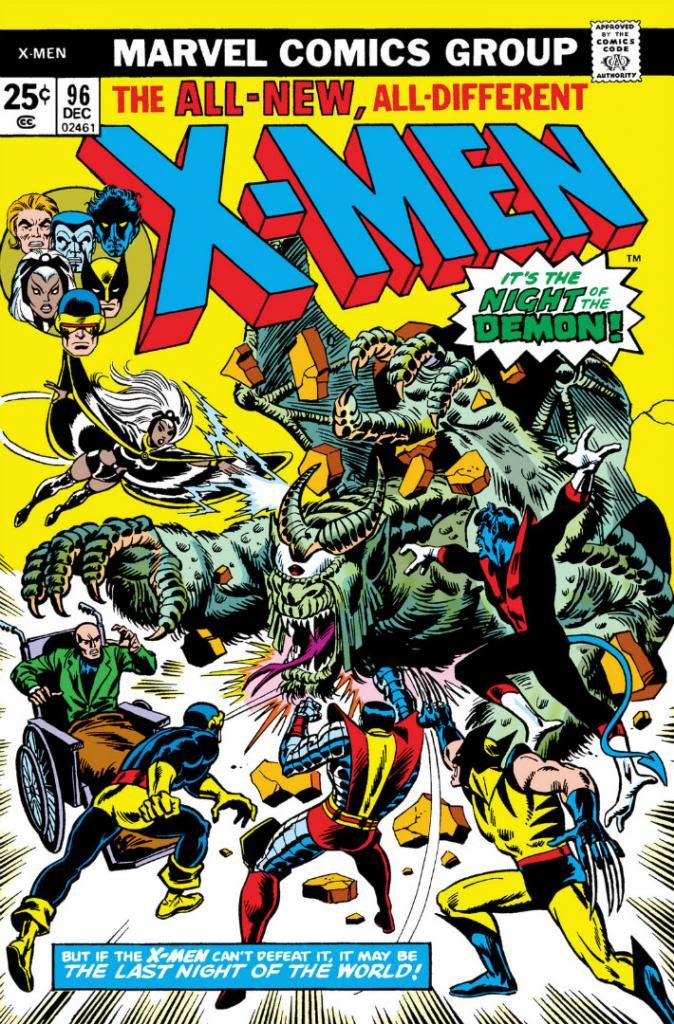
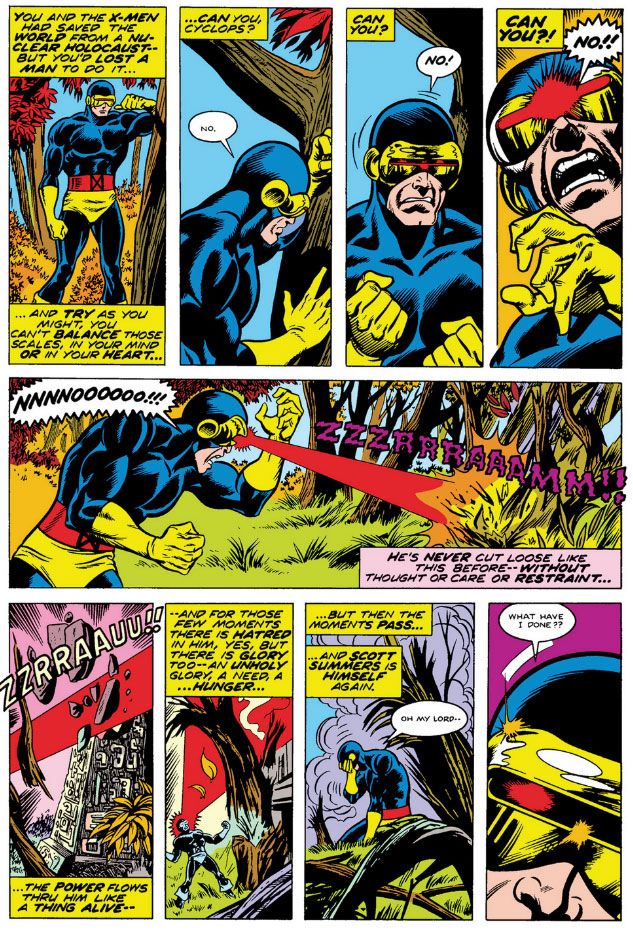
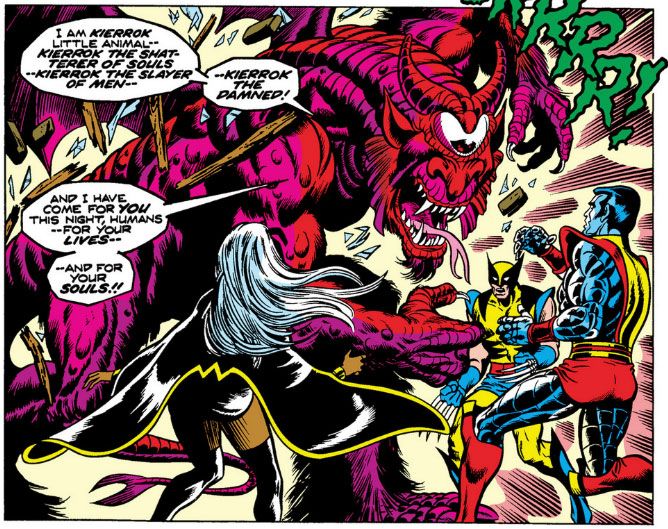


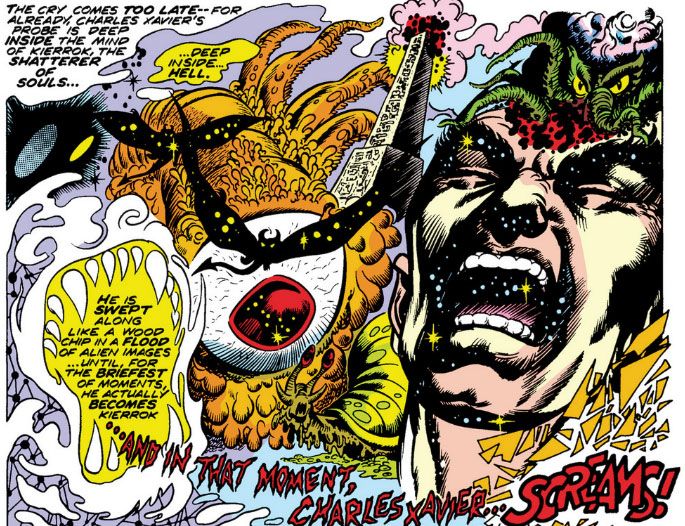

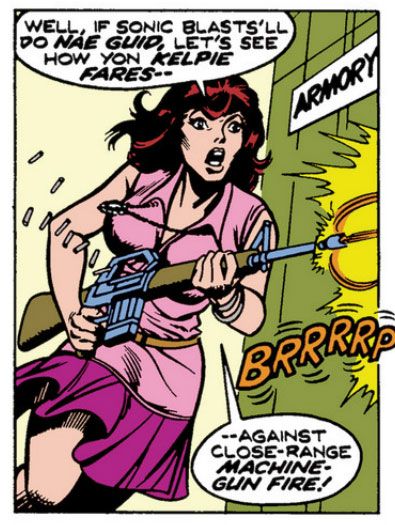
No comments:
Post a Comment